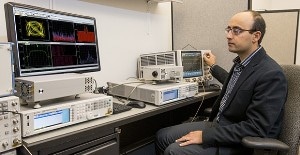Oct 13 2016
Boise State University electrical engineer Hani Mehrpouyan is principal investigator on an effort to open up new swaths of underutilized wave bands for wireless communication. The project is funded by a three-year, $1.25 million grant from the National Science Foundation, which recently announced several awards totaling $12 million to address challenges to public access to the radio spectrum.
 Hani Mehrpouyan uses the millimeter-Wave test and measurement equipment at Boise State University to perform phase noise measurement at 60 GHz. (Credit: Boise State University.)
Hani Mehrpouyan uses the millimeter-Wave test and measurement equipment at Boise State University to perform phase noise measurement at 60 GHz. (Credit: Boise State University.)
Wireless communication systems are in increasingly high demand among industry, government and the public to support the smart grid electrical infrastructure, homeland security, military applications, environmental monitoring, and medical and transportation advances.
Making better use of the under-utilized spectrum in the 30-300 GHz wave band (also called the mm-wave band), could allow providers to offer less costly service, and also lead to transformative cellular access and coverage improvements for current customers and the underserved. This project also addresses a number of stubborn technical obstacles limiting mm-wave band use.
“The radio frequency spectrum is a finite but exceedingly valuable natural resource that facilitates a variety of applications and services,” said Jim Kurose, assistant director of NSF for Computer and Information Science and Engineering (CISE). “The research activities supported by these awards represent bold new approaches with the potential to contribute to improvements in the efficiency of radio spectrum utilization while protecting passive sensing services.”
Mehrpouyan is working on the project, titled “Overcoming Propagation Challenges at Millimeter-Wave Frequencies via Reconfigurable Antennas,” with Hamid Jafarkhan, University of California, Irvine; Vida Vakilian, California State University, Bakersfield; and Nader Behdad, University of Wisconsin-Madison.
“This project may potentially have significant impact across a broad range of commercial, homeland security, infrastructure, aviation, medical, transportation and other fields that increasingly leverage and extend communication systems,” Mehrpouyan said.
The team hopes to create reconfigurable antennas with various states, each with varying and predefined radiation patterns. The antennas will support simultaneous transmission of multiple radiation patterns, each with large directional gain. The former provides beam diversity to overcome mm-wave frequency shadowing, while the latter reduces power amplifier design constraints
Should work prove successful, the team has strong industry connections that can help facilitate technology commercialization. Mehrpouyan founded Gigabit Technologies LLC, and the team also has close collaborations with the National Institute of Standards and Technology, Army Research Lab and National Aeronautics and Space Administration.
This material is based upon work supported by the National Science Foundation. Any opinions, findings, and conclusions or recommendations expressed in this publication are those of the authors and do not necessarily reflect the views of the National Science Foundation.